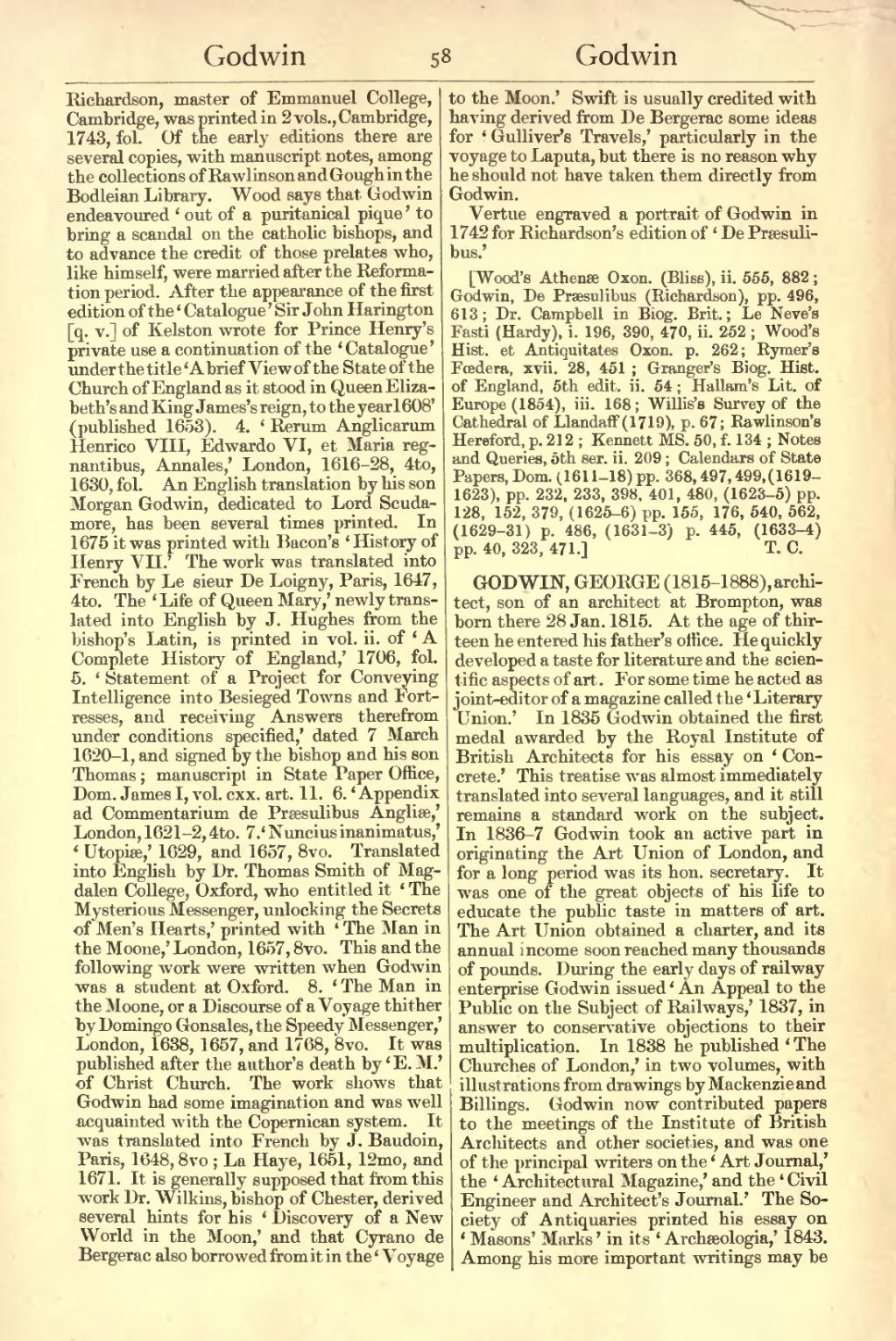Richardson, master of Emmanuel College, Cambridge, was printed in 2 vols., Cambridge, 1743, fol. Of the early editions there are several copies, with manuscript notes, among the collections of Rawlinson and Gough in the Bodleian Library. Wood says that Godwin endeavoured ‘out of a puritanical pique’ to bring a scandal on the catholic bishops, and to advance the credit of those prelates who, like himself, were married after the Reformation period. After the appearance of the first edition of the ‘Catalogue’ Sir John Harington [q. v.] of Kelston wrote for Prince Henry's private use a continuation of the ‘Catalogue’ under the title ‘A brief View of the State of the Church of England as it stood in Queen Elizabeth's and King James's reign, to the year 1608’ (published 1653). 4. ‘Rerum Anglicarum Henrico VIII, Edwardo VI, et Maria regnantibus, Annales,’ London, 1616–28, 4to, 1630, fol. An English translation by his son Morgan Godwin, dedicated to Lord Scudamore, has been several times printed. In 1675 it was printed with Bacon's ‘History of Henry VII.’ The work was translated into French by Le sieur De Loigny, Paris, 1647, 4to. The ‘Life of Queen Mary,’ newly translated into English by J. Hughes from the bishop's Latin, is printed in vol. ii. of ‘A Complete History of England,’ 1706, fol. 5. ‘Statement of a Project for Conveying Intelligence into Besieged Towns and Fortresses, and receiving Answers therefrom under conditions specified,’ dated 7 March 1620–1, and signed by the bishop and his son Thomas; manuscript in State Paper Office, Dom. James I, vol. cxx. art. 11. 6. ‘Appendix ad Commentarium de Præsulibus Angliæ,’ London, 1621–2, 4to. 7. ‘Nuncius inanimatus,’ ‘Utopiæ,’ 1629, and 1657, 8vo. Translated into English by Dr. Thomas Smith of Magdalen College, Oxford, who entitled it ‘The Mysterious Messenger, unlocking the Secrets of Men's Hearts,’ printed with ‘The Man in the Moone,’ London, 1657, 8vo. This and the following work were written when Godwin was a student at Oxford. 8. ‘The Man in the Moone, or a Discourse of a Voyage thither by Domingo Gonsales, the Speedy Messenger,’ London, 1638, 1657, and 1768, 8vo. It was published after the author's death by ‘E. M.’ of Christ Church. The work shows that Godwin had some imagination and was well acquainted with the Copernican system. It was translated into French by J. Baudoin, Paris, 1648, 8vo; La Haye, 1651, 12mo, and 1671. It is generally supposed that from this work Dr. Wilkins, bishop of Chester, derived several hints for his ‘Discovery of a New World in the Moon,’ and that Cyrano de Bergerac also borrowed from it in the ‘Voyage to the Moon.’ Swift is usually credited with having derived from De Bergerac some ideas for ‘Gulliver's Travels,’ particularly in the voyage to Laputa, but there is no reason why he should not have taken them directly from Godwin.
Vertue engraved a portrait of Godwin in 1742 for Richardson's edition of ‘De Præsulibus.’
[Wood's Athenæ Oxon. (Bliss), ii. 555, 882; Godwin, De Præsulibus (Richardson), pp. 496, 613; Dr. Campbell in Biog. Brit.; Le Neve's Fasti (Hardy), i. 196, 390, 470, ii. 252; Wood's Hist. et Antiquitates Oxon. p. 262; Rymer's Fœdera, xvii. 28, 451; Granger's Biog. Hist. of England, 5th edit. ii. 54; Hallam's Lit. of Europe (1854), iii. 168; Willis's Survey of the Cathedral of Llandaff (1719), p. 67; Rawlinson's Hereford, p. 212; Kennett MS. 50, f. 134; Notes and Queries, 5th ser. ii. 209; Calendars of State Papers, Dom. (1611–18) pp. 368, 497, 499, (1619–1623), pp. 232, 233, 398, 401, 480, (1623–5) pp. 128, 152, 379, (1625–6) pp. 155, 176, 540, 562, (1629–31) p. 486, (1631–3) p. 445, (1633–4) pp. 40, 323, 471.]
GODWIN, GEORGE (1815–1888), architect, son of an architect at Brompton, was born there 28 Jan. 1815. At the age of thirteen he entered his father's office. He quickly developed a taste for literature and the scientific aspects of art. For some time he acted as joint-editor of a magazine called the ‘Literary Union.’ In 1835 Godwin obtained the first medal awarded by the Royal Institute of British Architects for his essay on ‘Concrete.’ This treatise was almost immediately translated into several languages, and it still remains a standard work on the subject. In 1836–7 Godwin took an active part in originating the Art Union of London, and for a long period was its hon. secretary. It was one of the great objects of his life to educate the public taste in matters of art. The Art Union obtained a charter, and its annual income soon reached many thousands of pounds. During the early days of railway enterprise Godwin issued ‘An Appeal to the Public on the Subject of Railways,’ 1837, in answer to conservative objections to their multiplication. In 1838 he published ‘The Churches of London,’ in two volumes, with illustrations from drawings by Mackenzie and Billings. Godwin now contributed papers to the meetings of the Institute of British Architects and other societies, and was one of the principal writers on the ‘Art Journal,’ the ‘Architectural Magazine,’ and the ‘Civil Engineer and Architect's Journal.’ The Society of Antiquaries printed his essay on ‘Masons' Marks’ in its ‘Archæologia,’ 1843. Among his more important writings may be
